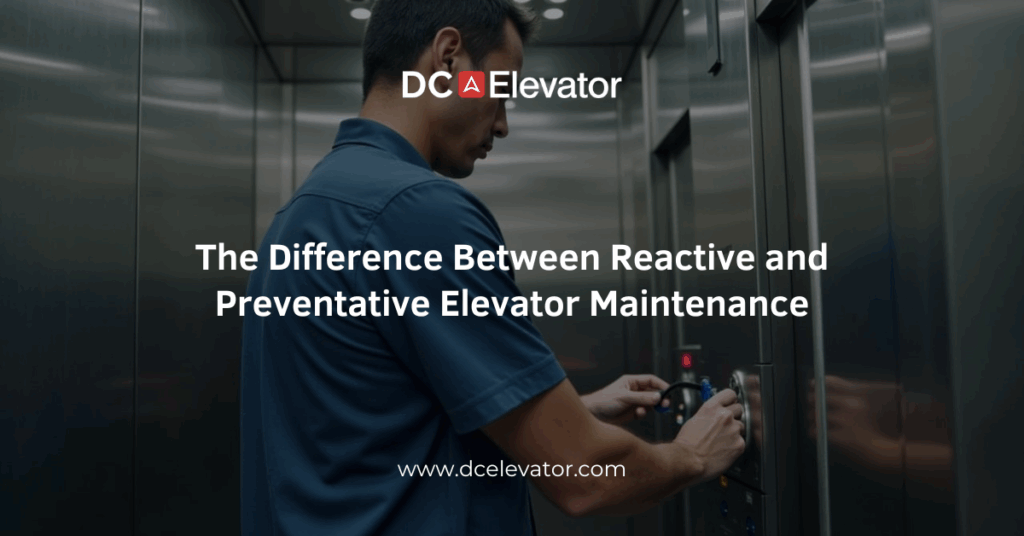What’s more expensive than a broken elevator? The lost productivity, tenant complaints, and emergency service calls that come with it. For facility managers and building owners, elevator downtime is more than an inconvenience—it can disrupt business operations, affect occupant safety, and tarnish a property’s reputation.
That’s why understanding the difference between reactive and preventative elevator maintenance is so crucial. While both involve addressing issues with elevator systems, only one helps avoid those issues in the first place. This blog will walk you through the key differences, benefits, and long-term impact of each approach—so you can make more informed decisions for your building’s vertical transportation systems.
Reactive vs. Preventative Maintenance: What’s the Difference?
Reactive Maintenance (Fix-It-When-It-Breaks)
Reactive maintenance is just that—responding to problems as they arise. It’s a common approach in older buildings or those with tight budgets. The elevator malfunctions, a service call is placed, and repairs are made to restore functionality.
The downside?
-
Higher repair costs over time
-
Longer and more frequent downtimes
-
Emergency call-out fees
-
Increased tenant dissatisfaction
Reactive maintenance often prioritizes short-term fixes over long-term performance. It can work in a pinch, but it creates a cycle of repairs that rarely addresses root causes.
Preventative Maintenance (Fix-It-Before-It-Breaks)
Preventative maintenance, on the other hand, is proactive. It involves regularly scheduled inspections, adjustments, lubrication, and part replacements—before a breakdown occurs. This approach helps ensure safe, reliable operation and extends the lifespan of elevator components.
Benefits of preventative maintenance include:
-
Reduced long-term costs
-
Fewer disruptions and unplanned outages
-
Better compliance with safety codes
-
Improved building reputation and tenant satisfaction
A comprehensive preventative plan looks at wear-and-tear trends, usage patterns, and age of equipment—allowing building managers to plan maintenance budgets more effectively.
Real-World Impact: A Tale of Two Buildings
Consider two commercial buildings with similar elevator systems.
-
Building A operates reactively, calling for repairs only when an issue is reported. Over five years, it has faced multiple shutdowns, paid thousands in emergency service fees, and seen complaints rise among tenants.
-
Building B, on the other hand, follows a structured preventative maintenance schedule. Its elevator system receives monthly inspections, minor adjustments, and part replacements as needed. It experiences minimal downtime, fewer complaints, and lower repair bills over the same period.
The difference? Planning ahead. Preventative maintenance not only preserves the elevator’s performance but also protects the building’s overall value.
Common Maintenance Challenges & Solutions
Challenge: Budget Constraints
Solution: Preventative programs can be tailored to fit budget cycles. Small, routine services often cost less than emergency repairs.
Challenge: Inconsistent Vendor Performance
Solution: Partnering with a reliable service provider ensures that maintenance is performed consistently and in accordance with code requirements.
Challenge: Aging Elevator Equipment
Solution: Preventative maintenance helps track component aging, so modernization needs can be identified early—avoiding sudden system failures.
The Long-Term Value of Being Proactive
Elevators are one of the most critical (and most used) systems in any mid-rise or high-rise building. Keeping them running isn’t just about fixing what’s broken—it’s about preventing breakdowns in the first place.
If you’re still relying on a reactive approach, it might be time to rethink your strategy. Proactive maintenance helps reduce risk, preserve asset value, and ensure smooth operations for everyone using your facility.
Conclusion & Call to Action
Whether you’re managing an office building, hospital, school, or residential complex, elevator reliability matters. While reactive maintenance may seem convenient in the short term, preventative maintenance is the smarter, more cost-effective path forward.
Not sure where your current elevator maintenance plan stands? Our team can evaluate your system and recommend a program that fits your building’s needs. Contact us today to discuss a preventative maintenance plan tailored to your facility.
